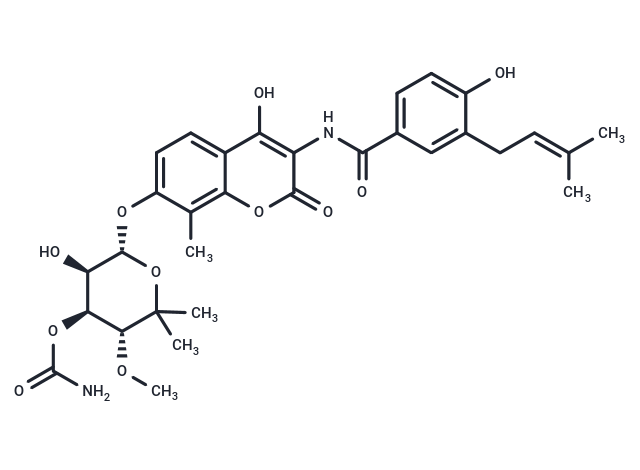Shopping Cart
Remove All Your shopping cart is currently empty
Your shopping cart is currently empty
Novobiocin is an orally active and potent antibiotic.Novobiocin is a DNA gyrase inhibitor and heat shock protein 90 (Hsp90) antagonist with inhibitory effects on gyrase and Hsp90. Novobiocin has anti-positive activity and can be used to study highly resistant pneumococcal infections.

| Pack Size | Price | USA Warehouse | Global Warehouse | Quantity |
|---|---|---|---|---|
| 2 mg | $35 | In Stock | In Stock | |
| 5 mg | $56 | In Stock | In Stock | |
| 10 mg | $81 | In Stock | In Stock | |
| 25 mg | $133 | In Stock | In Stock | |
| 50 mg | $198 | In Stock | In Stock | |
| 100 mg | $293 | - | In Stock |
| Description | Novobiocin is an orally active and potent antibiotic.Novobiocin is a DNA gyrase inhibitor and heat shock protein 90 (Hsp90) antagonist with inhibitory effects on gyrase and Hsp90. Novobiocin has anti-positive activity and can be used to study highly resistant pneumococcal infections. |
| In vitro | Novobiocin (1 mM) competitively hinders the binding of ATP to gyrase B, disrupting nucleotide binding, and impairs the interaction between the co-chaperones Hsc70 and p23 with Hsp90.[1] Novobiocin (200 µM; 24 h) results in the inhibition of the repair rate of DNA interstrand cross-links induced by both cisplatin (cis-DDP) and BCNU. This is accompanied by a corresponding reduction in the clonogenic survival of human glioblastoma multiforme cells.[2] Novobiocin (0.3 mM; 48 hours) triggers caspase-3/7 enzyme-dependent apoptosis assays, resulting in an approximate three- to fivefold increase in the number of apoptotic cells in K562, HL60, and Mutz-2.[5] |
| In vivo | Novobiocin (25, 50, 100, 200 mg/kg; s.c.; 4 times at 1, 5, 24, and 48 h after infection; Adult female Swiss mice (30g) with sepsis induced by the penicillin-susceptible strain (AR33118)) exhibits anti-infection activity in mice infected with amoxicillin-resistant Streptococcus pneumoniae.[3] |
| Synonyms | U-6391, U6391, U 6391, Cathomycin, Albamycin |
| Molecular Weight | 612.62 |
| Formula | C31H36N2O11 |
| Cas No. | 303-81-1 |
| Smiles | CO[C@@H]1[C@@H](OC(N)=O)[C@@H](O)[C@H](Oc2ccc3c(O)c(NC(=O)c4ccc(O)c(CC=C(C)C)c4)c(=O)oc3c2C)OC1(C)C |
| Relative Density. | 1.3448 g/cm3 |
| Storage | store at low temperature | Powder: -20°C for 3 years | In solvent: -80°C for 1 year | Shipping with blue ice/Shipping at ambient temperature. | |||||||||||||||||||||||||||||||||||
| Solubility Information | DMSO: 237.5 mg/mL (387.68 mM), Sonication is recommended. | |||||||||||||||||||||||||||||||||||
| In Vivo Formulation | 10% DMSO+40% PEG300+5% Tween-80+45% Saline: 5 mg/mL (8.16 mM), Sonication is recommeded. Please add the solvents sequentially, clarifying the solution as much as possible before adding the next one. Dissolve by heating and/or sonication if necessary. Working solution is recommended to be prepared and used immediately. The formulation provided above is for reference purposes only. In vivo formulations may vary and should be modified based on specific experimental conditions. | |||||||||||||||||||||||||||||||||||
Solution Preparation Table | ||||||||||||||||||||||||||||||||||||
DMSO
| ||||||||||||||||||||||||||||||||||||
| Size | Quantity | Unit Price | Amount | Operation |
|---|

Copyright © 2015-2025 TargetMol Chemicals Inc. All Rights Reserved.